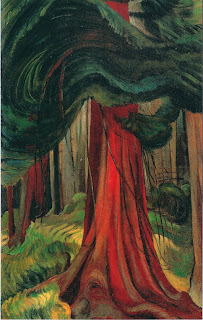
Monday, November 2, 2009
Sunday, November 1, 2009
Landscape Painting Reflective (250+ words)
During this process, I learned that the colour of an object does not have to be the same colour you paint on to the landscape. For example, in real life humans picture a road to be dark grey; whereas in my painting I made the road light grey and different shades of blue. Also, we picture mountains to be dark brown and/or black, in my painting I incorporated different shades of all the colours to create a sense of depth on the picture plane.
(Both are shown below)

Another technique I learned was dry-brushing. It is when you apply a little paint to the brush and then paint long lines, what happens is bits of paint are applied to the board and some of the colour underneath is visible. This technique also creates a sense of depth on the picture plane. An example of this is shown on the picture above in the mountain, the light blue greenish colour on top and the brown coming up from the bottom. (sorry about the picture being horizontal i don't know how to fix that)
Also, in Thursday's class I learned that when a person paints without any intention you can produce some amazing lines/colours. I think that when you paint you should let your mind take over and if you make a mistake not to paint over it or clean it off but leave it on and start from there and make something different out of it.
One area I feel I have to improve on is, not being afraid to paint different colours onto objects and not sticking to what a person sees in real life. In the fist couple of classes, I was only using primary and secondary colours to paint my landscape, but when Mrs. Cockburn suggested I use different shades, my painting began to improve. My road is not dark grey and my mountains are not black/brown, they are the colour that I wanted it to be, and because of that my painting looks much better that it did when I was only using the regular colours. To sum it up, I have to experiment with different colours and not be afraid to change something that does not look as it does in real life. I will ultimately create depth and also at the same time portray what is coming out of the individuals mind.
Landscape Painting: Artists

In Emily Carr`s paintings I noticed there is flow of wavy lines, the leaves in the tree for the picture on the top and the sky for the picture on the bottom. This ties in with my landscape picture because I have to make my street wavy and from looking at these 2 paintings it shows a great example of how to incorporate that. To do this in my painting, I will have to use long brush strokes which will start from one side of the road and extend to the other, when I paint that line I will have to make it wavy.
Also, I noticed in Emily Carr`s landscape painting above, the tree`s trunk is not brown and the sky is not entirely blue. This shows we do not have to paint the colours that first come to mind when we think of a specific object. For my painting many of the objects I have that are below the horizon are dark (road, mountains on each side) if I paint it the natural colour that comes to mind my landscape will be too dull, therefore, looking at Emily Carr`s colours I can make them different colours to liven the painting up and create a new perspective to that object. To do that I will make the road different shades of blue/grey, and for the mountain I will make the bottom layer brown and paint in lighter shades of different colours, hopefully that will not make the painting seem as dull.
Etienne Allegrain (International)
1644-1736
French Painter
Whats interesting about Mr. Allegrain's paintings is that his lines meet/vanish at the horizon. In the painting on the top the line that extends farthest out, curves around the trees and then disappears. In my landscape that is exactly what I have to do, my road has to disappear behind the mountain on the right. To do this, I will have to make the line disappear once it touches the mountain to give the impression that it has curved around.
Also, I noticed in the painting on the top the sky graduates from a dark blue to a light blue, it creates a nice affect and my painting also has the same technique, In my painting I start light and then go to an almost blackish blue. I used small strokes and made blocks of different shades of blue, then I blended the sides together so the viewers eye can easily flow from the lightest shade to the darkest.






.jpg)
.jpg)
.jpg)






